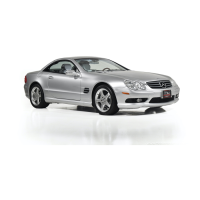
Do you have a question about the Mercedes-Benz 2003 SLK 230 Kompressor and is the answer not in the manual?
| Brand | Mercedes-Benz |
|---|---|
| Model | 2003 SLK 230 Kompressor |
| Category | Automobile |
| Language | English |
Recommendations for using genuine Mercedes-Benz parts and accessories for optimal performance and safety.
Guide to familiarize yourself with the vehicle's functions and instructions for safe operation.
Information on scheduled maintenance work and service booklet procedures for optimal vehicle upkeep.
Essential safety precautions and rules for proper and safe use of the vehicle.
Guidance on contacting Mercedes-Benz service centers for diagnosing and correcting vehicle problems.
Instructions on how to unlock the vehicle using the remote control and key.
Guide to adjusting seats, steering wheel, and mirrors for optimal driving position.
Key instructions and warnings for safe driving, including seat belt usage and child safety.
Procedures for safely parking the vehicle, engaging the parking brake, and locking doors.
Detailed information on seat belts, airbags, and child seat safety for occupant protection.
Explanation of systems like ABS, BAS, and ESP for enhanced vehicle stability and control.
Information on the immobilizer, anti-theft alarm, and tow-away alarm features.
Comprehensive guide to using the remote control, key, and central locking system.
Explanation of gauges, indicators, and warning lamps in the instrument cluster.
Instructions for operating the climate control for heating, cooling, and air distribution.
Guide to using the radio, CD player, cassette deck, and telephone functions.
Instructions for opening, closing, and manually operating the retractable hardtop.
Details on glove box, cup holders, storage compartments, and other convenient features.
Tips for fuel-efficient driving, safe operation, and handling various road conditions.
Information on checking engine oil, coolant, and other essential fluids under the hood.
Guidelines for tire maintenance, replacement, rotation, and checking inflation pressure.
Information on the Flexible Service System (FSS), service indicators, and recommended maintenance intervals.
Instructions for washing, waxing, and cleaning interior and exterior components.
Solutions for common dashboard warning lamps and indicator lights.
Information on the location of the first aid kit, tool kit, spare wheel, and other essential items.
Step-by-step guide for changing a flat tire, including using the TIREFIT kit or spare wheel.
Precautions for handling, disconnecting, and reconnecting the vehicle battery.
Instructions and safety warnings for jump starting a vehicle with a discharged battery.
Technical details on engine models, cylinders, displacement, output, and torque.
Information on approved tire sizes, rims, wheel offset, and winter tire recommendations.
Details on capacities for engine oil, transmission fluid, coolant, brake fluid, and recommended fuels.
Explanation of treadwear, traction, and temperature grades for tires as per federal safety standards.
Explanation of the Antilock Brake System's function in preventing wheel lock-up during braking.
Description of the driving convenience system for maintaining a set vehicle speed.
Explanation of the Electronic Stability Program's role in improving vehicle handling and directional stability.
Information on seat belts, emergency tensioning devices, and airbags as occupant protection systems.
Description of the TIREFIT kit for emergency and temporary tire repair.











